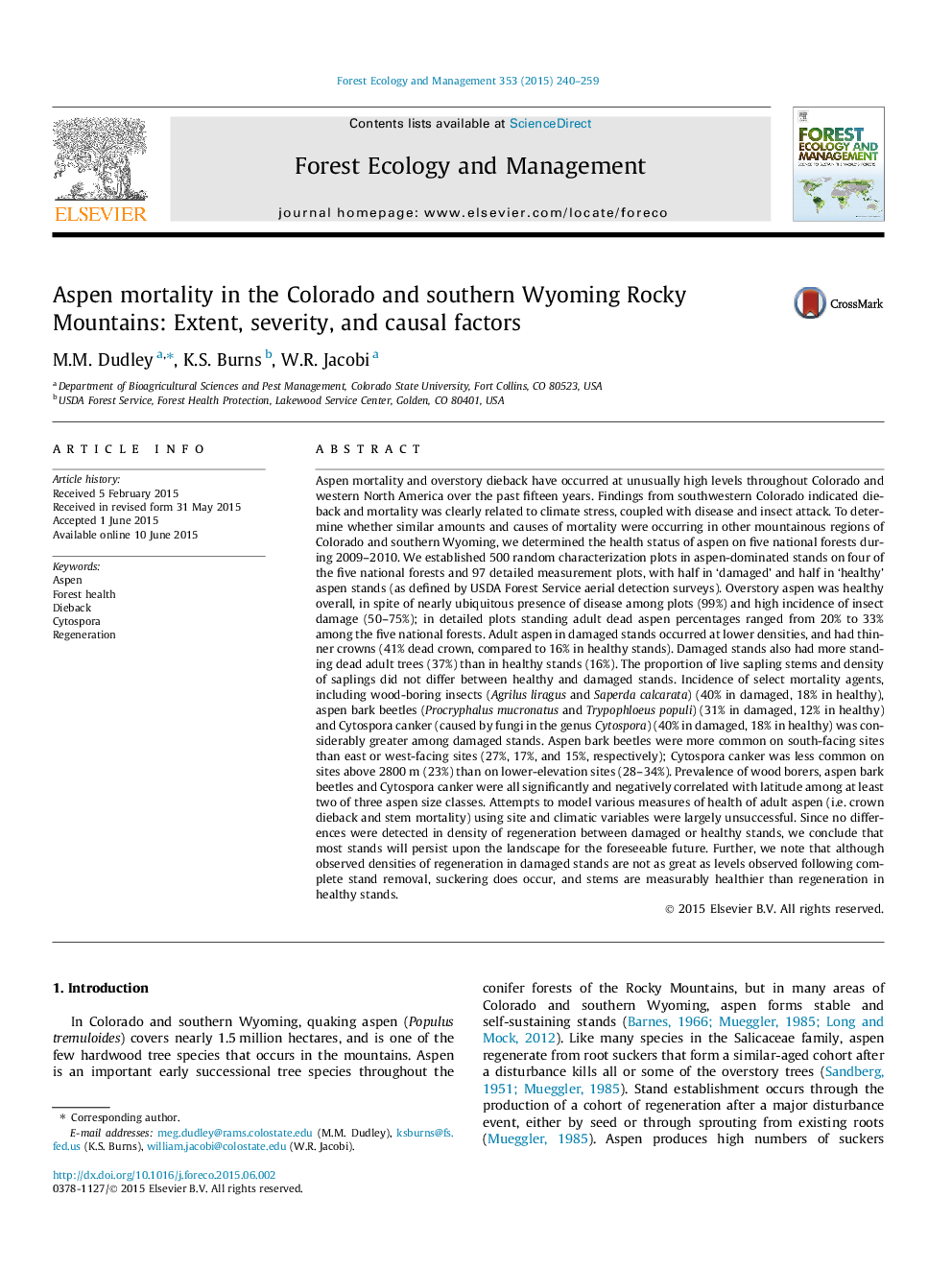| کد مقاله | کد نشریه | سال انتشار | مقاله انگلیسی | نسخه تمام متن |
|---|---|---|---|---|
| 86236 | 159172 | 2015 | 20 صفحه PDF | دانلود رایگان |
• We surveyed aspen stands with various mortality levels in CO and S WY in 2009–2010.
• Standing dead adults ranged from 20% to 37% across forests, with a mean of 28.5% overall.
• Stands west of the continental divide had larger diameters and healthier trees.
• Regeneration densities were similar in healthy and damaged stands.
• Cankers, bark beetles and wood borers were the most common damage agents.
Aspen mortality and overstory dieback have occurred at unusually high levels throughout Colorado and western North America over the past fifteen years. Findings from southwestern Colorado indicated dieback and mortality was clearly related to climate stress, coupled with disease and insect attack. To determine whether similar amounts and causes of mortality were occurring in other mountainous regions of Colorado and southern Wyoming, we determined the health status of aspen on five national forests during 2009–2010. We established 500 random characterization plots in aspen-dominated stands on four of the five national forests and 97 detailed measurement plots, with half in ‘damaged’ and half in ‘healthy’ aspen stands (as defined by USDA Forest Service aerial detection surveys). Overstory aspen was healthy overall, in spite of nearly ubiquitous presence of disease among plots (99%) and high incidence of insect damage (50–75%); in detailed plots standing adult dead aspen percentages ranged from 20% to 33% among the five national forests. Adult aspen in damaged stands occurred at lower densities, and had thinner crowns (41% dead crown, compared to 16% in healthy stands). Damaged stands also had more standing dead adult trees (37%) than in healthy stands (16%). The proportion of live sapling stems and density of saplings did not differ between healthy and damaged stands. Incidence of select mortality agents, including wood-boring insects (Agrilus liragus and Saperda calcarata) (40% in damaged, 18% in healthy), aspen bark beetles (Procryphalus mucronatus and Trypophloeus populi) (31% in damaged, 12% in healthy) and Cytospora canker (caused by fungi in the genus Cytospora) (40% in damaged, 18% in healthy) was considerably greater among damaged stands. Aspen bark beetles were more common on south-facing sites than east or west-facing sites (27%, 17%, and 15%, respectively); Cytospora canker was less common on sites above 2800 m (23%) than on lower-elevation sites (28–34%). Prevalence of wood borers, aspen bark beetles and Cytospora canker were all significantly and negatively correlated with latitude among at least two of three aspen size classes. Attempts to model various measures of health of adult aspen (i.e. crown dieback and stem mortality) using site and climatic variables were largely unsuccessful. Since no differences were detected in density of regeneration between damaged or healthy stands, we conclude that most stands will persist upon the landscape for the foreseeable future. Further, we note that although observed densities of regeneration in damaged stands are not as great as levels observed following complete stand removal, suckering does occur, and stems are measurably healthier than regeneration in healthy stands.
Journal: Forest Ecology and Management - Volume 353, 1 October 2015, Pages 240–259
